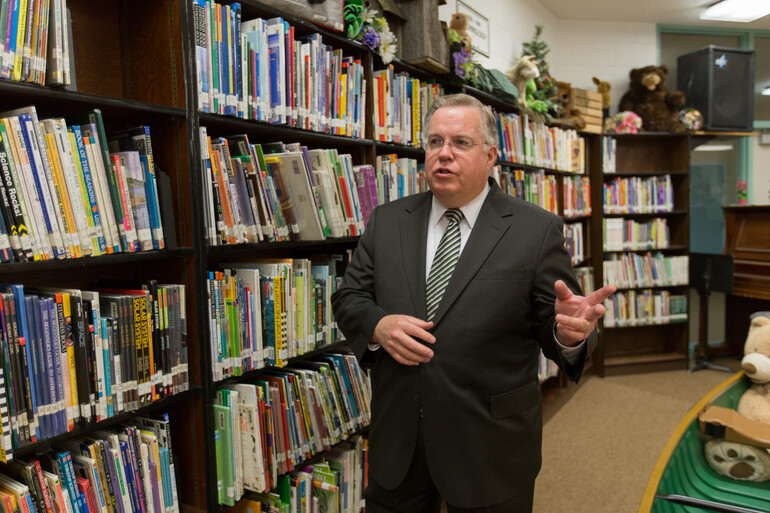Dennis Plubell is a professional Seventh-day Adventist educator. His role as North Pacific Union Conference (NPUC) vice president for education rests on a foundation of nearly four decades in academic hallways, classrooms and committees. His service spans local to national, from secondary school teacher to associate director of education for the North American Division. He is an educator through and through. Even his wife, Barbara, is a school principal. It runs in his veins — his father, Gilbert Plubell, has served the church in similar fashion, even in retirement.
So when you ask Dennis about the future of Adventist education here in the Northwest and beyond, his perspectives come from intentional and lifelong dedication. He, along with most other church educators from kindergarten through graduate school, recognize the challenges ahead seem unprecedented. They realize that status quo is not a viable option. While Adventist education is excelling in a host of ways, in many cases Adventist school enrollments are not keeping up.
Is Adventist education as we know it going to change? Will more schools like Ohio’s historic Mount Vernon Academy have to close? Will the set of problems we face today be answered with God-honoring solutions?
Dennis may not have all the answers, but he’s a good place to start.
GLEANER: Let’s talk about the reason Adventist education exists.
Plubell: We always begin with Ellen White’s assertion that “the goal of education and redemption are one.” Our children should be taught to “become thinkers, not mere reflectors” of the world around them. She encouraged us to believe that from the earliest ages children should be taught about their place in God’s kingdom, that their lives here on Earth can be a training ground for the world to come. While she promoted parents as the very best teachers of their young ones, she also recognized, early on, the need for a school system. Our schools have always sought to partner with parents in fulfilling the Scripture exhortation to “train up a child in the way he should go.”
GLEANER: The last couple decades have seen the confirmation of this in the large ValueGenesis and CognitiveGenesis studies.
Plubell: Educators and church members have learned a lot from those studies. While there are always exceptions, these research initiatives have confirmed that faithful attendance and participation in Adventist education give our children an enhanced advantage. They are more likely than other students to retain critical spiritual values and achieve beyond their projected cognitive performance ability at all grade levels in all types of Adventist schools. The more parents become partners in that process, the better the experience. Constant evaluation is part of learning how we can do better. Across the North American Division we have begun a new study called PhysicalGenesis. After assessing spiritual development with ValueGenesis and academic achievement with CognitiveGenesis, we want to determine the health and wellness of our young people. Are our children likely to embrace the healthy living principles of the Adventist health message? Will the next generation enjoy the “Adventist advantage” in healthful living featured in so many of the so-called Blue Zone reports?
GLEANER: Once the baby boomer generation moved through our educational system, it has seemed that critical numbers of students needed to maintain viable school operations have continued to slip. What factors have contributed to these trends?
Plubell: Despite the decrease, our church members are enrolling their children in Adventist schools at generally the same rate as in past years. But there are simply fewer school-age children available. We recognize there are increased economic demands on families including higher tuition costs. When you couple these with the changing norms in younger generations such as a greater reluctance to send children to boarding schools, the continued interest in home schooling and the cultural shift in priorities, the enrollment trends become more understandable. We have to admit as well that many of us, especially our young families, are less likely than in years past to simply do what’s always been done. In decades past, families sacrificed to send their children to an Adventist school because that’s what Adventist families did. Many families still do, but other available options now make that less likely. We are bombarded daily with media messages about how to measure quality education. Adventist educators have not yet effectively balanced that with affirming the value of our whole-child educational philosophy and the belief that genuine quality must include the Creator and Redeemer God at the center of Adventist Christian education. Our goal is not just success on this side of the Second Coming.
GLEANER: You say there are fewer Adventist children now that are of school age than in past decades?
Plubell: We have some evidence that in the past 10 years, from 2005–2015, the number of school-age children listed in our Northwest church rosters has declined dramatically. In one of our large conferences, it appears that we’ve decreased from around 5,500 to about 4,000 school-age children. And we’ve always only had a percentage of these actually enrolled in an Adventist school. That’s a significant decline. The demographic shift in our members, often called the “graying of Adventism,” cannot be ignored. But, the challenges to Adventist education are complex, and demographics alone cannot be our excuse.
GLEANER: Yet some of our schools have maintained enrollments with a significant percentage of non-Adventist community students.
Plubell: That’s true. We used to think of our schools more as “safe harbors,” where our Adventist students could be trained without the encroachments of worldly culture. Some of our schools, through both necessity and evangelistic strategy, have created more of an “outreach” philosophy. Small schools have continued to operate longer than they may have been otherwise able to because of the increasing numbers of community students. International students are included in many of our academies. School boards and church leaders talk frequently about maintaining a focus on mission and the core values of Adventist education in the midst of these shifting dynamics.
GLEANER: It seems that more of our schools are intentionally creating partnerships with home-schooling parents.
Plubell: It’s important to approach the education of our children as a partnership. We are all on the same team, with the same hopes and dreams for our young people. When our schools provide resources and activities for all Adventist students, including home-schoolers, the mission of our church gains. When we fail to find a common purpose, our mission suffers.
GLEANER: Some Northwest members remember the traumatic closure of Laurelwood Academy near Gaston, Oregon, years ago. Boarding academies today face new challenges. What is the future of our secondary schools?
Plubell: Successful leaders usually approach challenges as new opportunities. I remember well a presentation by John McVay, our Walla Walla University president, to Adventist K–12 educators a few years ago in which he reminded us that “our extremity is God’s opportunity!” One important thing to also remember is that the challenges will not go away by themselves. The challenges will require new solutions for a new generation in a new time, not the fixes that create the past for our generation past. We cannot ignore demographic realities and philosophical changes among church members, the parents of this generation. This is not an option. It’s interesting to note that for years, our largest academies were typically boarding schools. In 1980 there were 85 Adventist senior academies throughout North America of which 46 (more than half) were 9–12 boarding schools owned and operated by conferences. There are 106 senior academies today and only 31 of these are boarding schools — just 29 percent. Now, for the first time in the 2014–15 school year, the Northwest academy with the largest enrollment is a day academy — Portland Adventist Academy. The ongoing discussions at our boarding schools and across our conferences are necessary to plan a future based on real need, rather than “what we’ve always done.” Adapting the delivery of education does not mean we change our mission. It does not compromise our foundational principles. It is not a failure to adapt. It is a failure to not adapt.
GLEANER: Beyond the challenges, what excites you about the months and years ahead?
Plubell: How much space do you have? Well, let me touch on just a few.
- Our new Adventist Encounter Bible curriculum series is being debuted in ninth-grade Bible classes this coming fall (read more about this series at Encounter: A Fresh Approach to Bible Curriculum). This is a fresh emphasis on “whole person” education with sound pedagogy, inquiry learning and the Bible as the textbook. We are committed to raising a generation of youth who seek excellence only through first encountering Jesus.
- A resurgence of passion from members who see the value of Adventist education and have invested in schools and students. The stories from Oregon Conference (see Together as One for the Sake of the Gospel) are a great illustration of what can happen when pastors, teachers and members work together for a common goal, to be trustees of the education of God’s youth in our church.
- Northwest Hispanic membership growth has provided the NPUC Office of Education an opportunity to partner with local conferences, churches and schools to provide assistance for Hispanic students. Families who wouldn’t otherwise be able to put their children in Adventist schools have benefited from scholarships that are already impacting a new generation of youth.
GLEANER: You mentioned the lay members who have stepped up to aid Adventist education. That sort of commitment seems critical to the future of our schools and our students.
Plubell: My father grew up as one of five siblings in the Depression era. His parents were dirt-poor subsistence farmers, but their mindset was to give their kids an education to help them “finish the work.” Four out of the five, including my father, finished college. All were active church members. My father, Gil Plubell, was a denominational leader in Adventist education. I see some parents electing to send their children to schools that will give them an edge in science or basketball or some other skill. There’s nothing wrong with excellence in those areas in which a child is gifted. But I pray that we will not only affirm these gifts, but inspire these young students and their families with a dream of finishing the work — that the apparent sacrifice of this world’s accolades and measures of success will be worth the price. We see ever more clearly each day that the redemption of this world must be soon. Adventist education and the work of redemption are one and the same.










